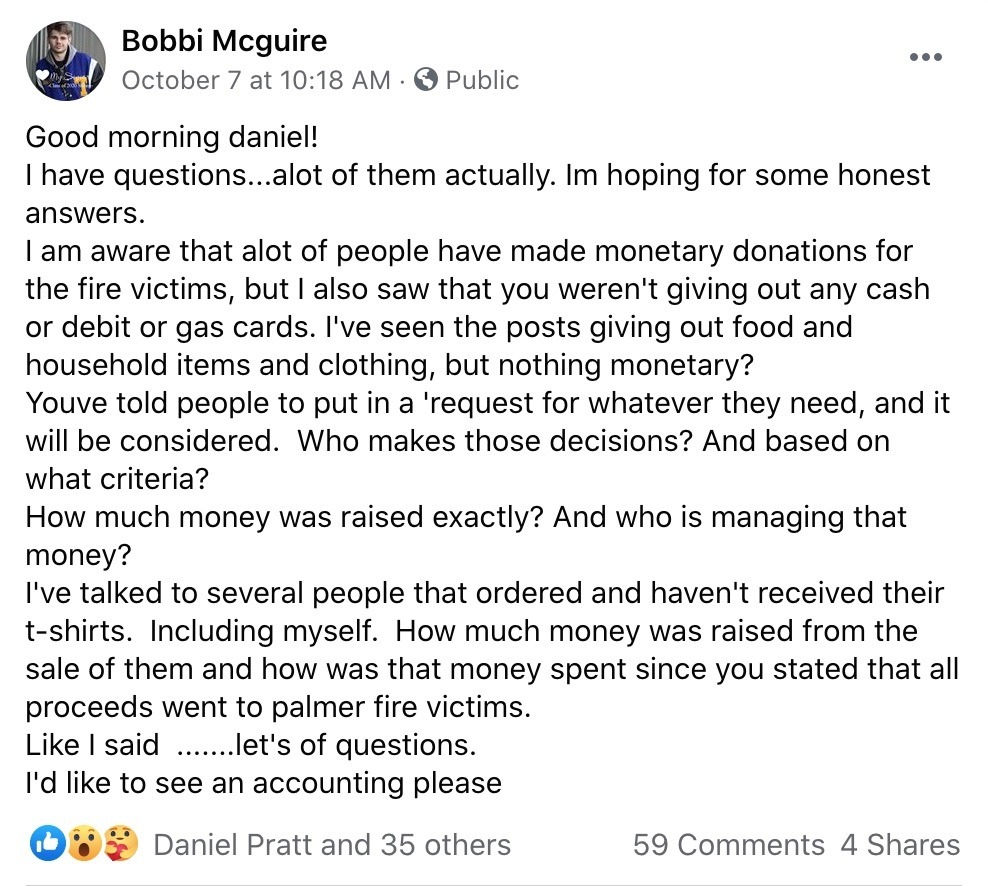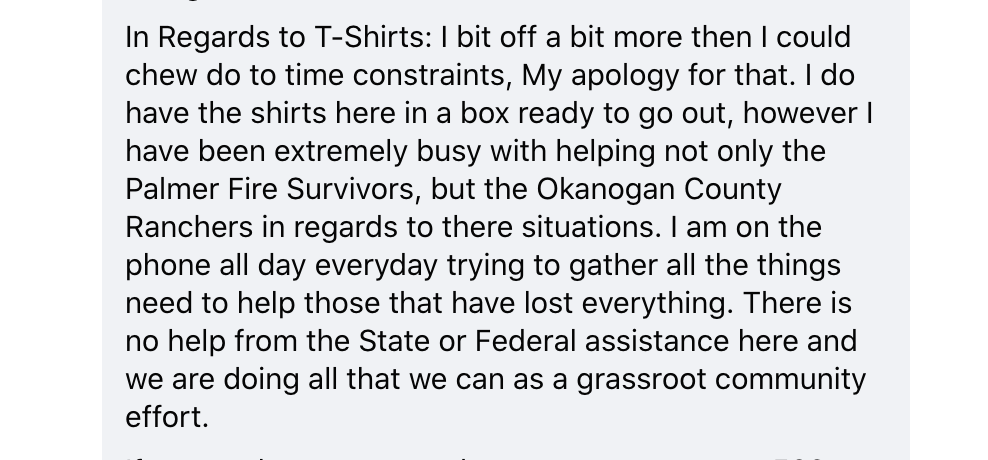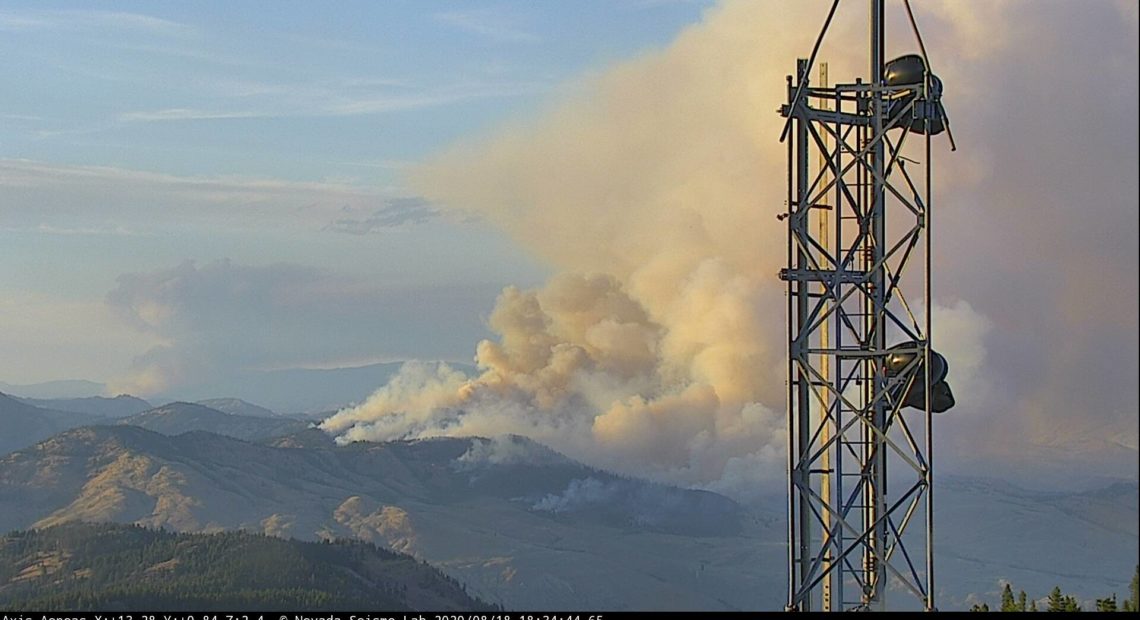
Eastern Washington Residents Praise Facebook Group For Connections During Trying Fire Seasons
Listen
Doug Coleman had just returned home after staying up for more than 24 hours. He was exhausted. He’d evacuated as the Cold Springs Fire came closer to his property. Flames quickly fanned across north-central Washington’s Okanogan County over Labor Day weekend.
He found his house – just outside of Okanogan – still standing. Little did he know, it was just the first time he would have to evacuate during this one fire.
Doug called his daughter Heather, who lives about two hours away in Wenatchee, and went to sleep.
“I said, ‘Well, hey. Go get some rest. I’ll just keep watching should the winds change and the fires head back your way,” Heather says.
Running on no sleep herself, Heather decided to check Facebook just as her workday started to get busy. She’s a member of the Okanogan Highlands Fire Watch group.
“Living in Wenatchee, I didn’t have any real-time access to any other means of communication on such short-time notice,” Heather says.
That’s how she first found out her father’s home was once again under a Level 3 – or Get Out Now – evacuation. She quickly called him.
“I said, ‘Hey, Level 3. Get the heck outta there!” Heather recalls.
Doug, a retired firefighter, threw on shoes, grabbed his go bag and jumped in his truck with his three dogs — Bernese mountain dogs Leo and Gus and German shepherd Anna.
Just then, a law enforcement officer tore up his driveway, making sure he knew to leave immediately.
“It was maybe 15 minutes after dad got down the hill that the fire crossed the road and then took out his house,” Heather says.
Heather credits Facebook and the OHFW group for helping keep her father and his dogs safe. Even though he’d prepared his house for fires, that area hadn’t burned since the 1980s.
“It was a very, very near miss,” Heather says. “(The Facebook group) very well could have been a life-saver for him.”
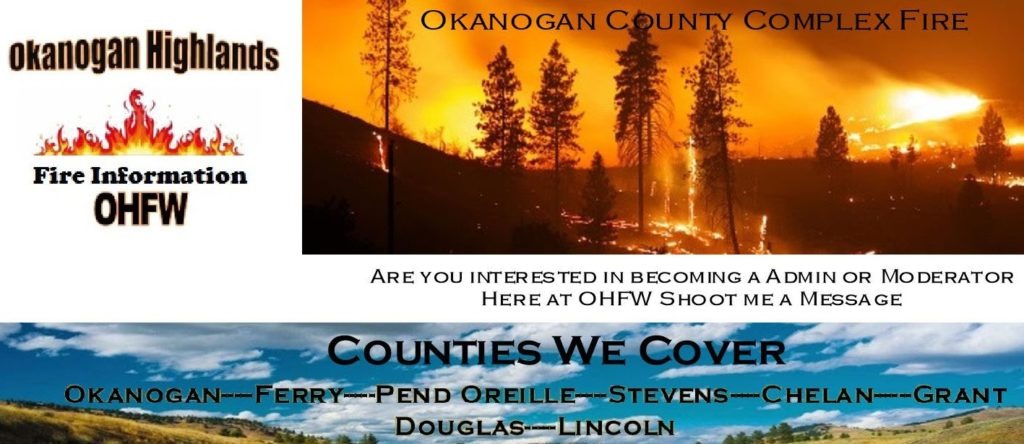
The header image for the Okanogan Highlands Fire Watch group on Facebook. Daniel Pratt started the group in 2015 during a particularly bad fire year in Okanogan County. It’s since expanded to nearly 18,000 members and to cover a wide area of eastern Washington
Formed In 2015
Daniel Pratt formed the Okanogan Highlands Fire Watch Facebook group in 2015. It was an idea that sort of “came out of thin air,” he says.
Pratt wanted to do something to help his neighbors. He initially set up the group, with 45 local members, to help navigate people out of harm’s way. The group blew up one night, as the 2015 Okanogan Complex fire raged and people searched for more information.
“A lot of people didn’t know where to go. They had no clue where to go. So we tracked roads and road closures,” Pratt says.
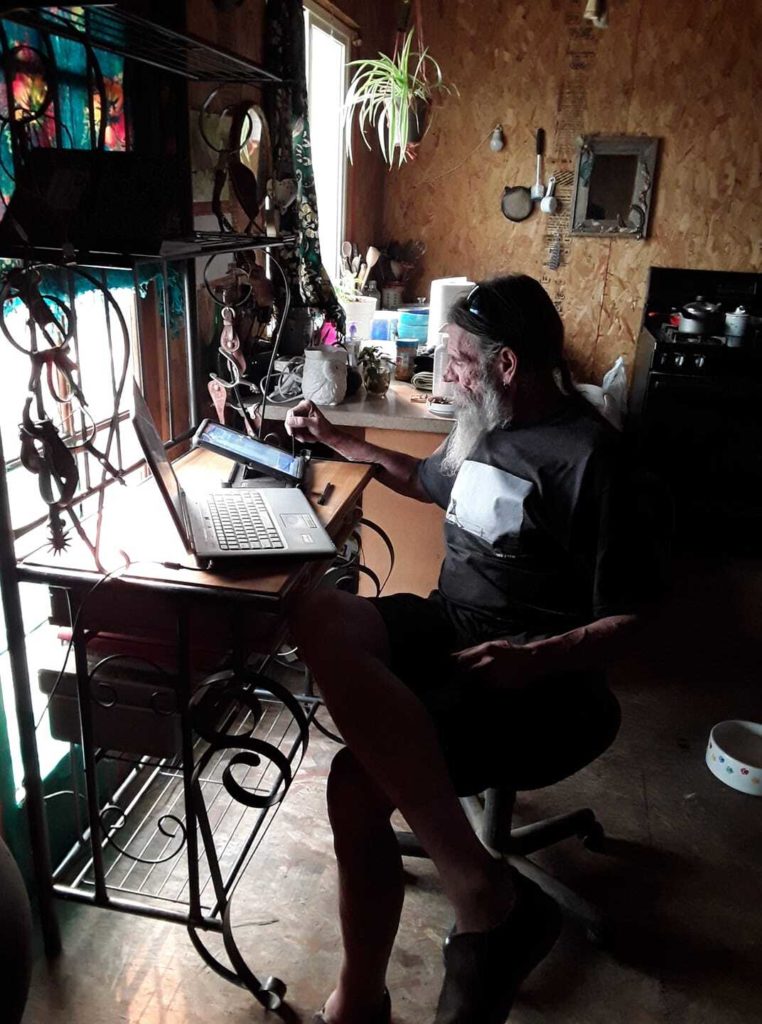
Daniel Pratt founded the Okanogan Highlands Fire Watch group on Facebook in 2015. We works the online community, and his phone, during the fire season. Courtesy of Daniel Pratt
Now, at around 18,000 members, the Okanogan Highlands Fire Watch group continues to provide what members call valuable and lifesaving information. People post evacuation notices, fire maps and recovery resources throughout fire season.
“The idea is to bring communities together to watch each other’s back. I want everybody to be kind, compassionate, loving to each other – something different than what the world is,” Pratt says.
But it’s a daunting task for the group’s administrators. It can lead to months with little sleep during busy fire seasons, constantly checking data, worrying about friends and neighbors and their own property.
The 16- to 20-hour days can be exhausting, says Katherine Gunn Bennett, a co-administrator for the group.
“By the end of fire season, I’m pretty much burnt out,” Gunn Bennett says. “Pretty much the whole summer is full of neglect. I get so involved with what’s going on, especially after a fire comes out, and I just don’t get (housework) done that I need to get done.”
At the beginning of May, her husband starts to roll his eyes, knowing she’ll be glued to the computer from the time she opens her eyes until she closes them. She loses hours at a time, answering questions and checking fire information.
“(We have) two dogs and a cat, and I’ve neglected them, also, because I’ll get so involved with what’s going on with the group that I forget to feed them. Boy, do I feel guilty,” Gunn Bennett says.
When fires break out, it’s “pure chaos,” she says, with information coming in so quickly.
“Everyone demands your attention right then,” Gunn Bennett says.
Questions pour in.
A few from one Facebook thread this year:



Administrators say they do their best to answer everything, or encourage group members to answer what they can.
“So we all feel that it’s just really important to keep people informed, up-to-date, in a timely fashion,” Gunn Bennett says.
“A Double-Edged Sword”
That drive to put out information quickly has been “a double edged sword” for Okanogan County Emergency Management director Maurice Goodall. Right now, he’s the sole person running the department and is working to hire an emergency management specialist.
During fire season, Facebook groups pop up, claiming to be official sources for particular fires, but they aren’t run by government agencies. Goodall says the numerous fire groups on Facebook give people information quickly, but it might not always be the whole story.
For example, he says: radio scanner traffic.
“Every single thing that is coming over that radio, if it was hard facts or not, they’re taking that up and putting it on Facebook,” Goodall says.
During this summer’s Palmer Fire near Loomis in Okanogan County, Goodall says he and a firefighter were talking strategy. The firefighter had to radio to get more information so that they could make a decision.
“I happen to be sitting here in my office with one eyeball open because I’ve been up all night, and I’m waiting for him to respond back to me,” Goodall says.
As he hears the radio conversation, before the firefighter can respond, the information was posted to a Facebook group.
“It’s a discussion that we’re trying to figure out what we need to do. Well, then you get people that are putting it on Facebook immediately without any filters. And, hey, we’re on the radio. Anybody can hear it. But the issue is: You can also get people scared,” Goodall says.
He wants information to be verified, like what goes out over the county’s alert system. Goodall says that makes information slower, but more accurate.
“Sometimes it’s hard because in today’s society, we want all that information yesterday,” Goodall says.
Different Philosophy
Official sources and Facebook groups have a different philosophy on information. Goodall says he doesn’t want to hide anything; he just wants to make sure information is accurate. The OHFW group administrators say people have the right to information immediately.
Pratt prides the OHFW on its speed and the amount of information he and Gunn Bennett can quickly deliver to the public. He says they don’t post speculation.
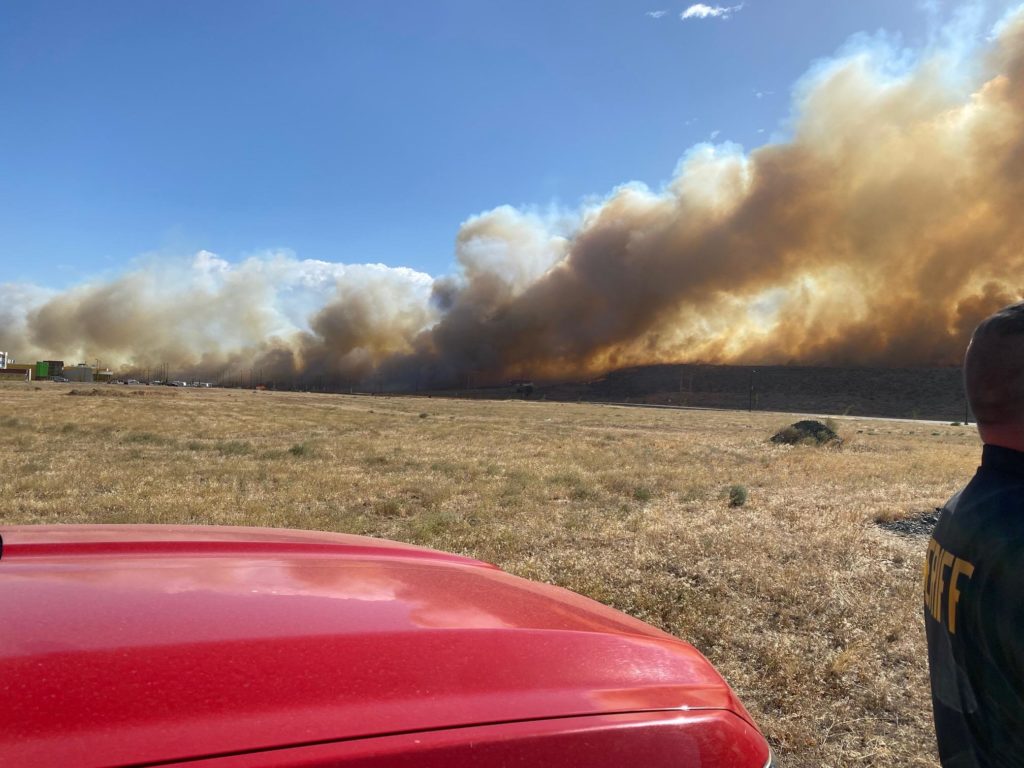
The Cold Springs Fire burns in Okanogan County on the reservation of the Colville Confederated Tribes on Sept. 7, 2020, near the 12 Tribes Casino in Omak. CREDIT: InciWeb
“It says a lot when a citizen can actually get the information out before emergency management,” Pratt says.
The reach of the ever-expanding group has also helped get out public health information, says Liz Walker, director of Clean Air Methow.
As hazardous and unhealthy smoke lingered throughout the Northwest, Walker cross-posted information to Okanogan Highlands Fire Watch from the Methow Clean Air program. She says her Clean Air posts got more views than ever before, allowing her to reach more people. Some posts about the air quality index received 10 to 20 times more views than normal, Walker says.
It’s important “to make sure information about smoke is being provided by experts who can give the public health information that’s necessary to people,” she says.
Walker says that in an area with fewer monetary resources, the OHFW group has become a “phenomenal resource.”
“The (OHFW) Facebook page, to me, is the beauty of the natural inventiveness and creativity and just roll-up-your-sleeves that has been the heart of what living in a rural community means,” Walker says.
A firefighter from Chehalis says OHFW has helped his crews know what’s going on before they arrive on scene. Kevin VanEgdom is the mobilization coordinator for Lewis County Fire District No. 5, which has about eight paid staff and 20 volunteers.
VanEgdom says postings from the group help prepare in the moments before fire districts are mobilized to respond to large fires in other parts of the state. Once mobilization happens, crews have 60 minutes to hit the road, so warnings an hour or so earlier help him organize his firefighters. Crews can be based at fires for up to three weeks.
He says firefighters also watch the OHFW group as they drive the three-plus hours to Okanogan County. VanEgdom says they can get information on wind speeds, evacuation notices and fire growth.
“(It helps) just to mentally prepare. If you have high winds, or the fire growth is fast, then the techniques that you’re going to use to fight the fire could be different,” VanEgdom says.
Pratt, the OHFW founder, says industry relationships have allowed him to have “boots on the ground” access to fire information, as crews fight fires.
“(The information) just comes to me. I don’t have to actually go looking for it,” Pratt says.
Hopes To Expand
This season has been so successful, Pratt says he’s working on attaining 501(c)(3) nonprofit status. He has plans to update communications software and wants to expand to include resources for wellness and mental health, relief and recovery efforts. He’d like to start compensating people who have so far volunteered.
Eventually, he’d like to expand his operation to cover all of Washington state. He calls this group a “monster of (his) own making,” taking on the responsibility of gathering and disseminating information.
Pratt is working with a tax attorney, pro bono, to set up a new corporation and attain the 501(c)(3) nonprofit status.
Debbie Dunn, a partner at Perkins Coie, says she’s seen the IRS approve nonprofit status in as little as two weeks, recently during the COVID pandemic. She says it normally takes six to nine months.
Dunn says once the new corporation is formed, all contributions made before the nonprofit status is approved will retroactively receive tax deductions.
Several people in the OHFW Facebook group raised concerns about accounting for monetary donations and the purchases of t-shirts. Pratt started selling t-shirts a week after the Palmer Fire ignited in mid-August to raise money for people who had lost their homes. Now, he’s also selling hoodies.
Profits from the sales were to go to the Oroville/Tonasket Long Term Recovery group, which was recently renamed the Tonasket Oroville Disaster and Relief Team. He collected $21, with $4 for shipping, per t-shirt via PayPal. Sales were also set up at the Community Cultural Center of Tonasket and the OHFW store on Facebook. Pratt says he created a spreadsheet to track the payments and sizes of the orders.
A few people posted questions to the OHFW Facebook page:
Pratt says the t-shirts are a way he is personally raising money. He says he spent his own money to get the venture started. “It has nothing to do with the corporation,” he says.
Pratt responded on Facebook. He addressed the t-shirt concerns as part of a lengthy comment:
He recently asked his wife to help with the t-shirts. She’s now organizing the orders to ship out.
Pratt says he is only keeping track of money that’s coming in for the t-shirts. Local businesses are collecting monetary donations at their stores, which are going to the Tonasket Oroville Direct Relief Team.
For example, he says, Tonasket House of Cannabis put a donation box in its store and is matching all donations once a month for the next three months.
“I’ll go down, once a month, and count the money with the manager and make a deposit to (the Tonasket Oroville Direct Relief Team),” Pratt said in a recent interview with NWPB after questions about the handling of donations.
He says the deposit matches the money counted out with the business manager.
Pratt says he prefers to connect people to resources and material donations — like asking Habitat for Humanity to build cabins for people who lost homes in the Palmer Fire. That project is expected to start Oct. 22. Two churches and Habitat for Humanity will help build eight cabins.

T-shirts the Daniel Pratt was selling on the Okanogan Highlands Fire Watch group on Facebook on display in Tonasket this summer. Courtesy of Ed Koonce/OHFW-Facebook
“We’re not here to hide anything,” Pratt says. “I’m as transparent as I can be. I put my phone number out there. I told several of these people (with questions about money), if you think you have a leg to stand on, then file a complaint (with the sheriff). I’m good with it,” Pratt says.
A person also raised concerns that the group is not giving out cash donations to fire survivors.
Pratt says he is asking people to submit requests for what they need – items such as generators, RVs and water barrels. Those requests will be prioritized for people who live in the area and lost homes, starting with women, children and senior citizens.
“We know for a fact, that if we give cash to people, they may turn around and use that funding for something else, other than it was meant to be. So we’re very cautious about what we’re doing,” he says.
Nonprofit Status
Creating a nonprofit is a lengthy and complicated process, says Daniel Parkhurst, policy and communications director for Washington Nonprofits, which advocates for and helps nonprofits in the state. He says it’s important to be thorough and accurate as groups work toward tax-exempt status.
Parkhurst says it’s a good idea to hire an accountant or tax attorney, especially when dealing with IRS 990-series tax forms, which are public information.
“There are certain things that you need to rely on a professional. (For example), the electric work, the plumbing in your home, you should really rely on a professional because the damages if you do it wrong are very large,” Parkhurst says.
In the immediate aftermath of a natural disaster, like wildfires, Parkhurst says it may be best to just help out existing nonprofits. But, he says, as longer efforts to recover and rebuild kick off, local nonprofits can play a key role.
“If you see a crisis that you think is going to take years to work on, years to make positive change, forming a nonprofit could be very much worth it,” Parkhurst says. “In some ways, these big national efforts don’t necessarily include the local need. Not just on a state, not even on a county, on a small community level, your needs may be unique and different than many others.”
Connecting In Tragedy
Daniel Pratt says he is focused on helping his community. One moment from this fire season sticks out in his mind the most.
In September, the group was able to help when two parents, Jamie and Jacob Hyland, and their 1-year-old son went missing during the Cold Springs Fire. The Hyland family had been visiting land in Okanogan County they’d just inherited. They were found a day later, severely burned, their son Uriel had died. (A GoFundMe fundraiser for the family’s recovery has raised more than $350,000 as of Oct. 15.)
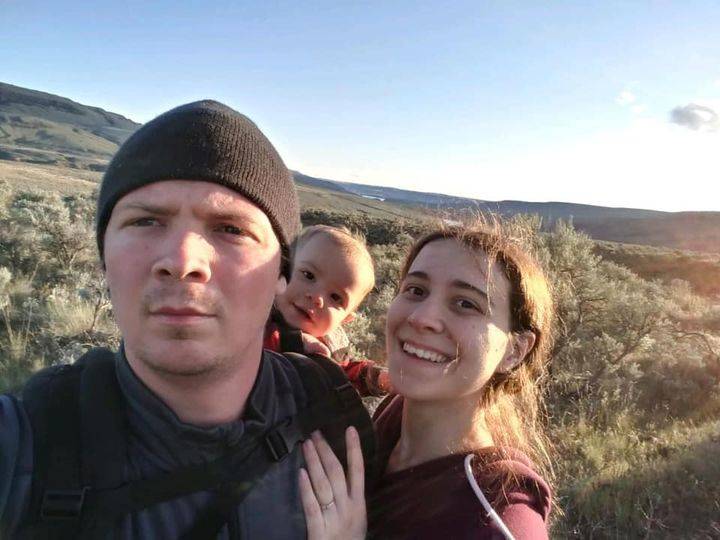
Jake and Jamie Hyland were critically injured while fleeing from the Cold Springs Fire on Labor Day 2020. Their 1-year-old son Uriel did not survive. The parents were still recovering in a Seattle hospital as of Oct. 13, 2020. Courtesy of Tammie Mabry/GoFundMe
Pratt says that as rescuers made their way to the family, his group set up a private messenger for family members who live out-of-state. Pratt reported the radio scanner communications to family members as Jamie and Jacob Hyland were rescued.
“I don’t think many people ever get that opportunity to help a family like that,” Pratt says.
Other community members say the group has given them peace of mind. Carol Johnson lives outside of Tonasket. Her home sits “up in the hills.”
Johnson says she’s always had “great fear” of wildfires. That fear has grown as recent fire seasons have seemed relentless.
“You find yourself scanning the horizon all the time. If you hear an airplane, you start looking along the horizon,” Johnson says. “And almost always, when you hear the airplanes, you will find the smoke.”
Her brother lost everything on his property except his house during the Okanogan Complex in 2015, the fire season that was the spark for Pratt creating the Facebook group.
“You didn’t know what was going on. You didn’t know how bad it was. You knew they told you to evacuate, but you didn’t have any information about it except that you knew you were scared,” Johnson says of the 2015 fires.
Her other brother lost a cabin in the Whitney Fire this year.
Now, she constantly checks the Okanogan Highlands Fire Watch page. Johnson says she has relayed information from the page to a friend who was trying to evacuate this summer and couldn’t be online.
That information makes Johnson less anxious.
“It takes so much of the fear out of not knowing because you have a place to go where you actually know what’s going on,” Johnson says.
Courtney Flatt covers fire, environmental and natural resource issues for Northwest Public Broadcasting. She is based in the Tri-Cities. On Twitter: @courtneyflatt
Feedback / News Tips: Email NWPB
Related Stories:

US Forest Service employees return to work after mass terminations
Katijo Maher, president of a local chapter National Federation of Federal Employees, stands next to a fire danger sign Tuesday in Leavenworth. Maher said she has 37 years of experience
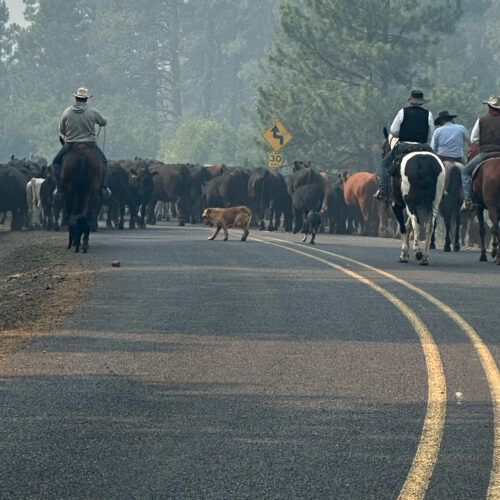
Burnt over cattle and lands: In southeast Oregon, grief-stricken ranchers are exhausted and frustrated by wildfires
Moving cattle out of a forest recently outside of Burns, Oregon. (Credit: Sabrina Maki) Listen (Runtime 4:33) Read Exhaustion and frustration: Ranchers in southeast Oregon are battling wildfire. Like many

Fire at Odesza Gorge concert lasted for five minutes, law enforcement officials say
This file photo from June 17, 2023, shows Sub Focus performing at the Gorge Amphitheatre. (Credit: Northwest News Network file) Listen (Runtime :53) Read This past holiday weekend turned fiery


